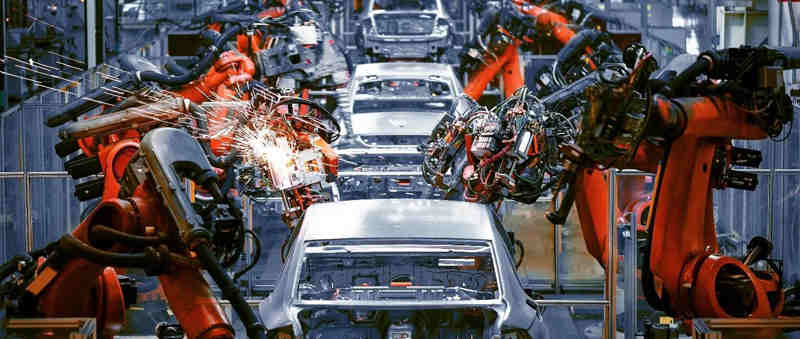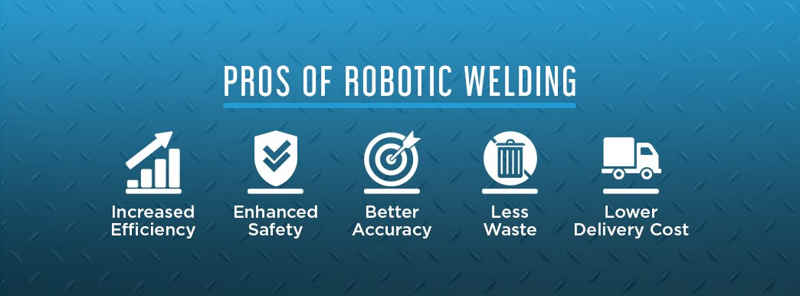Table of Contents
Robotic Welding
We are living in an era where more than 50% of products require welding. That’s why welding is included among the fast-growing industries. But do you know that there is a shortage of professional welders?
In the US, it is expected that by 2024, the industry will be 400,000 welders short. This means the companies need more workers and skilled labor to ensure consistent growth. That’s where robotic welding can rescue the manufacturing industry.

The robotic welding market is growing with a CAGR of 8.91%. This simply means that more and more manufacturers are trusting robots for welding.
These machines can handle all types of welding and come in various forms. You can buy robotic welding equipment according to your company’s requirements. We have written a concise guide to making the process easy for you. This article will provide you with the basic knowledge and right information about welding robots.
What Is a Robotic Welding System?
A robotic welding system consists of mechanized tools and a program. During the process, machines handle the parts and bond them through welding. However, the process is supervised and controlled by certified welders.
The robotic welding technology is praised for its precision, greater safety, and quick results.
What Is Robotic Welding Used For?
The industrial welding processes require a high level of precision to ensure the quality of products. These processes require temperatures that often reach thousands of degrees and are run at high speeds. This is why robotic welding is considered a more suitable option.
Robots welding systems improve the efficiency of the production lines. They not only work faster but also keep the labour safe.
Robotic welding is most commonly used in the automotive industry. These machines are used for arc welding and resistance spot welding to ensure high quantities of products.
How Do Robotic Welders Work?
A robotic welder normally consists of an arm that moves in three dimensions. There is a wire feeder attached to the arm and the endpoint contains a high-heat torch.
The filler wire is sent to the robot through the wire feeder. The torch then melts the metal wire to complete the welding process.
However, robotic welding does require human operators to monitor the process. Like manual welders, these operators are required to get certification from the concerned authority. In the United States, the American Welding Society (AWS) certifies these operators.
Welding robots are controlled through controllers that are programmed by operators. The best part is that modern robots are easy to program.
The controller can be used to set new programs, change parameters, and move the robotic arm. It is easy to use and an operator can start welding by pushing the button
How Fast Can a Robot Weld?
A robot can weld metals at a speed of 100 inches per minute. But you should know that this is considered a high speed for robotic welding.
The speed of robotic welding can vary depending on the nature of the task.
It all depends on for which purpose you are using the robot. A high speed for robot welding can be 60 in. /min in some cases. The same robot may offer a considerably fast speed of 80 in. /min.
Types of Robotic Welding
There are different types of robotic welding that are being used. We have discussed the 7 basic types of welding below.
1. Arc Welding Robots
This is one of the most commonly used types of welding. In this process, extreme heat is generated by an electric arc to melt the meal. The heat level often reaches up to 6,500 degrees Fahrenheit.
The metal molten during the process is used to unite different parts. Thus, it creates a bond that after cooling, solidifies into a stable connection. Arc welding robots are helpful when a company wants to connect metals on a larger scale.
2. Robotic Resistance Welding
This is the type of welding which is used when companies want to lower the costs. The method involves the passing of an electric current between two metal bases to melt the metals. This molten metal is then used to weld the metal parts together.
3. Spot Welding Robots
Not all metals are ideal for resistance welding, so companies use the spot welding technique. The process is more commonly used in the automotive industry. An automobile consists of various metals and therefore a spot welding method is preferred.
Robotic welders use a variation of resistance welding to overcome this issue. To overcome the issue, these machines link thin metal sheets in a single spot to weld the parts.
4. Gas Metal Arc Welding (GMAW)
This is a fast method of welding that involves a high level of deposition. During this process, a metal wire is moved towards the welder. The heated tip melts the wire and drops the molten metal onto the desired location.
The gas melting arc welding robot bonds the base part to other pieces. The process is also known as MIG welding.
5. Gas Tungsten Arc Welding (GTAW)
Gas tungsten arc welding (GTAW) or TIG welding requires high precision from robots. In this process, the electric arc passes between the metal base and a tungsten electrode to weld the parts.
6. Robotic Laser Welding
Laser welding robots are preferred when you need both accuracy and speed. These robots can join a high volume of metal parts.
Laser welding is often used to connect small metal parts. This type of robotic welding is more common in the jewellery and medical industry
7. Plasma Welding Robots
Robotic plasma arc welding or PAW is a complex method and requires a significant degree of flexibility. The process requires desired temperatures and speed of gas that passes through the nozzle. This is something that a robot welder can do more proficiently.
Benefits of Robotic Welding
If you are thinking about the benefits of robotic welding, robots have plenty to offer. These programmed machines can uplift your product quality while boosting productivity levels.

Below are some major advantages of using welding robots.
Better Efficiency
There is no need to clarify the stance on this point, right?
Robots can operate and complete tasks continuously without needing a break. They don’t need time off or a recreational break, unlike humans. In fact, robots can work on a straight 24-hour shift.
Robotic welding systems can accomplish tasks much faster thanks to their quicker speeds. They can help you improve the production line goals as they can work for long hours.
Improvement in Safety
Welding is a process that is associated with brightness and high-temperature levels. Robotic welding systems are loaded with plenty of security features. These machines not only work faster but also ensure that the labor is kept safe.
A safer workplace means there will be fewer injuries and insurance claims. This will improve job satisfaction among employees and save additional costs for the company.
Better Accuracy
Industry work, especially welding, is a repetitive task that requires expertise. A little mistake can jeopardize the whole process or project. There are always chances of errors during manual welding because humans aren’t prone to errors.
But when we talk about welding robots, you can completely trust them.
Welding robots can perform repetitive tasks with higher accuracy without making any errors. They can follow the same pattern with the same level of attentiveness.
Less Waste
When welders make mistakes, it not only costs in terms of time but also materials. Parts that are welded mistakenly or have weak junctions often cannot be used. This is a price that you have to pay when you hire manual welders to do the job
Robots, on the other hand, make fewer mistakes and work with high accuracy. And fewer mistakes during welding means less waste of material.
Lower Cost
You may be surprised to read this because robotic welding isn’t cheap. We agree that purchasing robots is a huge investment but they are cost-effective in the long run.
Eventually, welding robots will recoup their cost with their high productivity. You will be able to complete projects in less time, with less labor, and more accurately.
Takeaway Words
Investing in robotic welding is a good decision for manufacturing companies. They can run the welding process for long hours without needing more specialists. Plus, the work will be completed in fewer hours with higher accuracy and precision.



